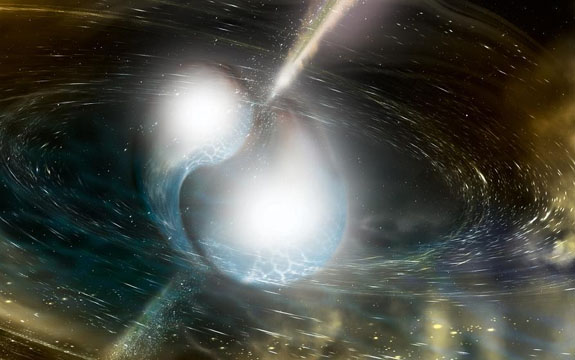Research captures wonders of the universe, and imaginations

In Summary
One of the great things about science is that the money we invest in research often brings a return through commercially useful discoveries or advances that improve the quality of life for us all.
Even in my field of astrophysics, research discoveries have been made that led to huge practical benefits. For example, Wi-Fi, which all of us use every day, is the result of CSIRO mastery of fourier techniques that were being used for both astrophysics and applied research.
But astrophysics also reveals inherent wonders about the universe, and in this past year we have hit some phenomenal goals.
On October 17, for the first time, scientists measured the violent death spiral of two dense neutron stars — the dense cores of stars that have exploded and died — as they collided at nearly the speed of light, creating what many called the greatest fireworks show in the universe.
Not only did we see the collision, we could hear it as the two stars, each the size of a city, completed 4000 orbits in the last 100 seconds of their cosmic dance.
It was a landmark discovery from an international team that included almost 100 Australian scientists and it resonated with the public in a way that only black holes, dying stars and fireballs in the universe can do. It was science at its most impressive, almost inconceivable yet intensely fascinating. It also reminded us that basic science — the science that isn’t immediately geared towards industrial applications — remains immensely important.
A century ago, Albert Einstein realised that gravity could be mimicked by acceleration — that light bent when passing near massive objects, and that the fabric of space-time could be shaken by the acceleration of the stars and planets.
A natural consequence of his theory was that stars beyond a certain density would collapse to become black holes, terrifying objects that possessed such strong gravity that not even light could escape them. He also predicted that the stars and planets emitted a strange and mysterious new form of radiation known as gravitational waves. But was Einstein right? Did black holes exist and did his equations correctly describe their behaviour? Does time really stand still in their vicinity and do gravitational waves permeate the universe? These are questions that are incredibly fundamental to how the universe ultimately works but that Einstein thought were impossible to verify experimentally.
It appears completely ludicrous to even think about trying to do experiments on black holes when you realise that you’d have to shrink the Earth into a ball just 2cm in diameter for it to become one. For our sun the black hole diameter seems more achievable, more like 6km — except when you learn that the sun weighs about 300,000 Earths and about 18 billion tonnes has to fit in every cubic centimetre.
This year’s Nobel prize winners in physics (Rainer Weiss, Kip Thorne and Barry Barish) realised that it was possible to build a machine that could hypothetically detect colliding black holes or their ultra-dense cousins, neutron stars, in the nearest million galaxies — should they exist and ever collide. Their detector, called Advanced LIGO, was the first to have a realistic chance of detecting the ripples in space-time induced by Einstein’s gravitational waves.
The technology behind this facility is staggering. More than 1000 people from around the world have contributed to the instruments, which fire powerful lasers at pairs of mirrors (beautifully polished in Australia) hanging from complex suspensions 4km away in the world’s largest vacuum tubes. Australia is one of four countries in the project.
When Advanced LIGO began its science operations in September 2015, it started listening for tremors in the fabric of space-time for the first time.
Remarkably, it wasn’t long before LIGO saw a burst of gravitational waves from two black holes as they destroyed each other in the last few orbits of a death spiral that probably had been under way for billions of years.
Black holes are deceptively simple objects, defined by their mass, spin and charge, and the pair involved in the September 2015 event were about 1300 million light years away.
Their detection proved that gravitational waves existed and that black holes 30 times the mass of our sun did too. For the first time scientists got to experiment with gravity in the vicinity of a black hole.
In August this year the first pair of merging neutron stars were seen by LIGO. Neutron stars are so dense that a teaspoon weighs a billion tonnes, but when they collide they produce an explosion that briefly creates a fireball in the sky. This event proved Einstein’s postulate that the speed of gravity and the speed of light were equivalent, to four parts in 10,000 trillion — one of the most precise confirmations of a physical law in the history of physics.
Last Thursday the Australian Research Council Centre of Excellence in Gravitational Wave Discovery was opened by federal Education Minister Simon Birmingham. The centre, which has been operating since April, has been born in a year that will likely go down in history as a monumental one for astrophysics.
The existence of the centre, and the excitement surrounding gravitational wave science, is testament to those who believe that basic science, the science of discovery, is a goal unto itself. This year, the LIGO gravitational wave detectors acted like a stethoscope, allowing us to listen to the vibrations in the fabric of space-time.
The appeal of the resultant science — which may not have any immediate monetary worth — is fascinating because it is truly universal, intangible and priceless.
This article was originally published in The Australian. Read the original article here.

